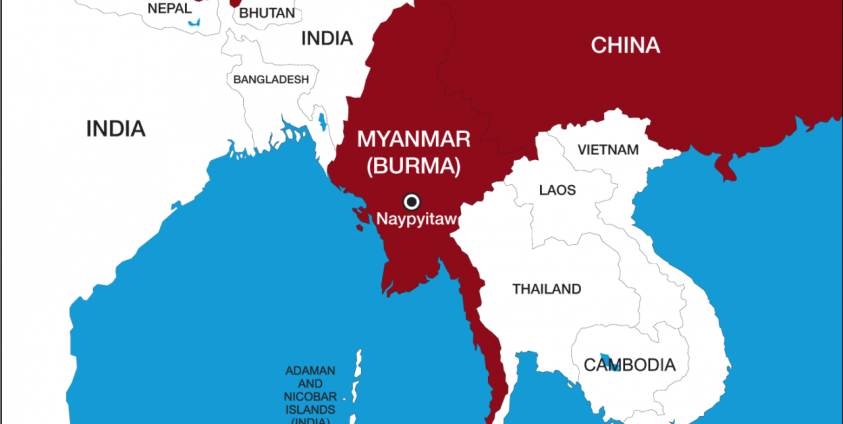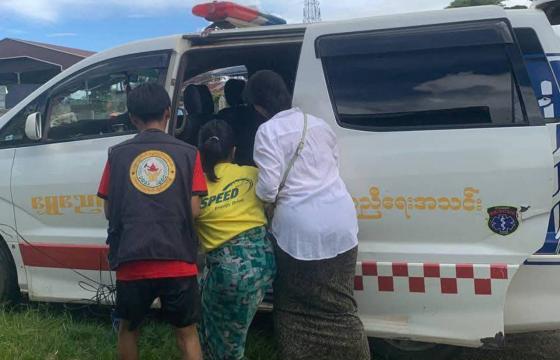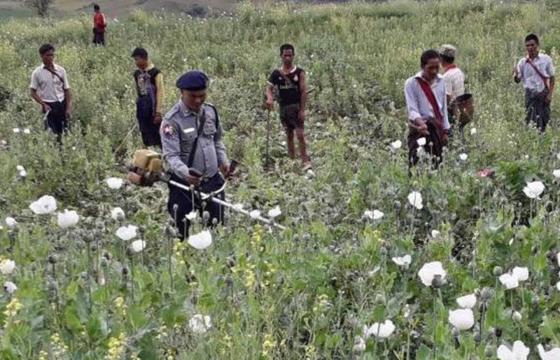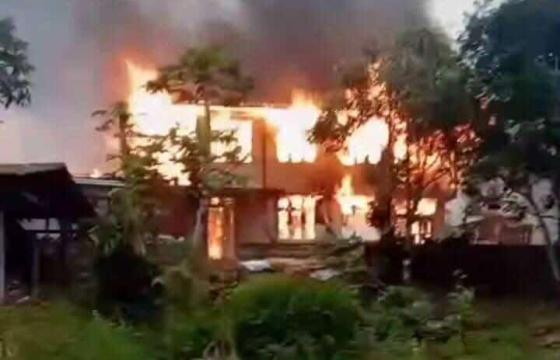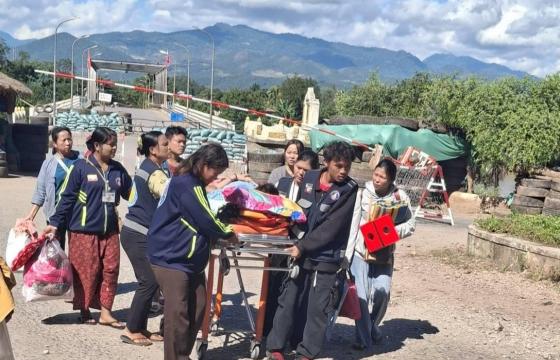Sai Wansai — It is very unfortunate that after only ten years of relatively free and open atmosphere, within the time span of nearly 60 years from 1962 to 2021, Burma, also known as Myanmar, again descends into military dictatorship. And since February 1 of this year, the country reverted back to total authoritarian military rule in its rudimentary form with unmatched barbarism, to subdue and cow the population into absolute obedience.
To date some hundreds have been killed, thousands put behind bars, and terrorizing the population with random shooting, using live ammunition and employing snipers to shoot and kill the public, who are against the military coup and junta’s rule.
According to Assistance Association for Political Prisoners (AAPP), 250 civilians were confirmed shot by the junta’s troops, known as Tatmadaw or military, to date.
“As of March 21, a total of (2665) people have been arrested, charged or sentenced in relation to the attempted military coup on February 1. Of them, (15) were convicted; (2) to two years imprisonment, (1) to three months, (2) to one year imprisonment, (2) to one month imprisonment, (8) to three months imprisonment. (109) have been charged with a warrant and are evading arrest, (375) were released. A total of (2290) are still under detention or have outstanding charges/evading arrest, including the (15) sentenced,” reported the AAPP.
The people on the ground estimated that some 600 might have been killed by the military, as the casualty figures counted were not comprehensive, leaving out the forced disappearances and secretly cremated individuals by the junta’s hangmen, including some that were not reported and unable to be registered. If we will ever be able to find out the real death toll will remain an open question for now.
With such unfolding scenarios, the question arises if the country is heading towards a failed state from a fragile one. But first let us look at the criterion of a failed state.
Failed State
“A failed state is a government that has become incapable of providing the basic functions and responsibilities of a sovereign nation, such as military defense, law enforcement, justice, education, or economic stability. Common characteristics of failed states include ongoing civil violence, corruption, crime, poverty, illiteracy, and crumbling infrastructure. Even if a state is functioning properly, it can fail if it loses credibility and the trust of the people,” according to Robert Longley.
(Source: Longley, Robert. “What Is a Failed State? Definition and Examples.” ThoughtCo, Feb. 17, 2021, thoughtco.com/what-is-a-failed-state-definition-and-examples-5072546.)
In his key takeaways of failed states, he writes:
- Failed states have become incapable of providing the basic functions of government, such as law enforcement and justice, military defense, education, and a stable economy.
- Failed states have lost the trust of the people and tend to suffer from civil violence, crime, internal corruption, poverty, illiteracy, and crumbling infrastructure.
- Factors contributing to state failure include insurgency, high crime rates, overly bureaucratic processes, corruption, judicial incompetence, and military interference in politics.
- As of 2019, Yemen was considered the world’s most-failed state, followed by Somalia, South Sudan, and Syria.
From the keytakaways let us examine where Burma now stands under the coup-maker, military junta regime.
The first point indications of failed states are what Burma is experiencing today. It doesn’t has the capability to provide basic functions of the government from law enforcement, justice, military defense, education, to stable economy.
In fact the junta’s law enforcement is employed to crush the public popular uprising with extreme barbarity by shooting to kill, detaining and terrorizing the population day and night. It is hardly in line with how a government would act or the international norms in handling public unrest, without justice whatsoever, not to mention its task to uplift education or create a stable economy.
The second point is failed states losing the trust of the people, suffering from civil violence, crime, corruption and poverty, which are what the country is enduring today.
But the important aspect to note is that committing and facilitating of the above mentioned issues are caused by the military single-handedly and not by the public, as it is on the receiving end of the military’s merciless crackdown.
The third point which includes insurgency, high crime rates, corruption, judicial incompetence, and military interference in politics are all present in Burma, which contribute to become a failed state.
As of 2020 fragile states index of Burma/Myanmar ranked number 22. It also pointed out as alert with 94.0 points from maximum 112 points, as of 2020. But in Responsibility to Protect Monitor Atrocity Alert, No. 244, March 17, Burma has shot up to become a country of concern where populations are at risk of, or are enduring, mass atrocity crimes.
People’s Resistance
After a few weeks of nationwide protest following the February 1 military coup, the public is changing its tactics to guerrilla style protest or flash mobbing to show their displeasure and the demand to end the military dictatorship.
In some parts of Yangon and Mandalay the Generation Z embolden by the Committee Representing Pyidaungsu Hluttaw (CRPH). Acting parallel government to the military junta, stance of self-defense rights against the military started to resist the suppression with whatever they have at their disposal, such as Molotov cocktails, sling shots, bow and arrows and the likes. Rumors have it that the kids are now being trained on how to handle war weapons as they have decided not to be sitting ducks anymore. These developments go parallel to form a federal army together with the ethnic armed organizations (EAOs), which have been up in arms against the successive military-dominated governments for decades.
On top of this the CRPH acting government announced the military junta as terrorist organization, while at the same time declared that EAOs are no more illegal armed organizations but legitimate entities, which may be able to become part of the to be formed national unity government.
This process is ongoing and the CRPH said it has been negotiating with the EAOs and also ethnic political parties (EPPs) in its endeavor. Its Acting Foreign Minister Zin Mar Aung recently told the media that eighty percent of the task have been finished to form the national unity government, which is believed to be promulgating a federal union Constitution and abolishing the military-drafted 2008 Constitution.
In short, the people’s movement can be understood as having three pillars, which are CRPH acting government, civil disobedience movement (CDM), and anti-junta or anti-dictatorship rallies nationwide. It is believed that the acting government CRPH will transformed itself into a national unity government and compete for legitimacy, which is already ongoing, with the junta regime in international arena and also domestically by erecting a parallel administration network countrywide, which is progress.
Present Situation
The CRPH on March 1 declared the military junta a terrorist group and likewise, it was announced by the junta as an illegal organization on March 23, and even asking the Interpol to arrest the CRPH members, although it is not clear what the Interpol will do with the request, as the junta is not yet recognized as legitimate government by any country so far.
On March 21, in Sagaing Region, Katha District, Indaw Township 15 person from Nabar police station and their family members moved to Indaw Town, due to the animosity of the public and encirclement of the police station. Other police stations from other townships were also said to be moving out to the bigger towns as they feared that the public will storm the stations, according to the Khit Thit Media.
On March 21, in southern Shan State, Pekong Township two military officers and two soldiers were reportedly killed by the people, according to a DVB report.
On March 23, soldiers and police reportedly detained around 50 civilians for questioning on Monday afternoon after two regime soldiers were beaten to death in Dawei, Tanintharyi Region, according to local residents, reported Myanmar Now.
Myanmar Now, on the same date compiled the casualty figures of the junta’s troops as 29 in total.
According to it, within fifty days after the military coup, the junta’s troops suffered at least 14 confirmed killed in Myawaddy, Hpaekong, Depaeyin, Dawei and Kyaukpadaung.
Besides, 15 junta’s troops were reported to be killed according to the social media in Aungban, Mandalay, Meiktila, Bago, Pauk and Pyinmana, which still cannot be confirmed.
Shortly after the CRPH’s rights to self-defense statement on March 14, armed resistance by the youth in form of using Molotov cocktails, slingshots, bow and arrow to self-made rocket launchers and wooden clubs were seen to be used against the junta troops on the Facebook.
The majority think just because the people don’t have guns the military and police are doing whatever they like.
“We don’t expect anymore that the UN will come. Let the CRPH form the army. We will enroll. We can’t go on looking at these guys killing people as they wish anymore,” are dialogue phrase that speaks for a lot of people, who are against the military-coup.
Most of the youth who endorsed CRPH said that they will serve in the federal army if it is formed in their Facebook; and they also welcome the Karen National Union (KNU) and Kachin Independence Army (KIA) for fighting against the junta’s military, according to an article in The Irrawaddy, Burmese section, on March 21.
On March 22, the U.S. Department of the Treasury’s Office of Foreign Assets Control (OFAC) sanctioned two individuals (Lt. Gen. Than Hlaing Chief of the Burma Police Force and Deputy Home Affairs Minister Than Hlaing & Lt. Gen. Aung Soe Bureau of Special Operations commander) and two entities (Light Infantry Division 33 and 77) connected to the Burmese military and its violent repression of pro-democracy protests. Treasury took these actions in response to the Burmese military’s continued campaign of violence and intimidation against peaceful protesters and civil society, according to its press release.
Analysis
As things now stand, we have the junta on one side and the CRPH on the other, with potential incorporation of the EPPs and EAOs, if the they all could agree upon the vision and future of the country.
But the bigger picture to contemplate is on how the conflict situation will unfold.
The military junta staged coup d’eta arguing that election was fraud, when in fact that it cannot allow the civilian government to chip away its political power and wanted to restore the scenario of pre-2011 era, where the military backed Union Solidarity and Development Party (USDP) will rule again as a military bloc, which includes the appointed 25 percent MP in parliament together with the right to administer the home, defense and border affairs ministries. And as such, it is not in a position to back down and return to pre-coup situation, with the NLD at the helm, from its point of view. But it doesn’t know either on what to do except employing increased violence against the public.
From the people’s perspective, including the whole opposition camp against the junta, only the exit of the military from political arena and restoration of the electorate desire will be acceptable. This should either be that the military goes back to the barrack for good and/or accept the total dismantling of military dictatorship.
And with the polarization of the two camps, the violence is bound to increase perpetrated by the military. The counter resistance will also become more organized from the opposition, which could involve the EAOs in the ethnic states and urban guerrilla warfare outfits within Burma’s heartland, where the majority of the Bamar live.
There is a likelihood that such scenario will come to light which would mean the country could be divided into various control zones by different parties, administering the divided country, which would become more like Yemen, Syria and Somalia failed states.
The KIA is already fighting widely in Kachin, northern Shan states but whether the intensity will increase or decrease in the future is anybody’s guess. The KNU has also increased its military activities and the junta’s army is said to be responding in kind, with reinforcement.
If the Bamar mass who are itching to fight back materialize their armed resistance in populated urban centers, the way to become a failed state will be only a matter of time.
Thus, it is time for regional powers such as India and China, including the ASEAN, should earnestly think and act to hinder the ongoing murder of the civilians which is threatening to exacerbate and abetting the emergence of a failed state at their door steps. It is in the interest of all the countries around Burma and beyond to halt such a development and tragedy from happening, in the name of humanity if not for anything else.


